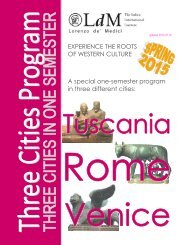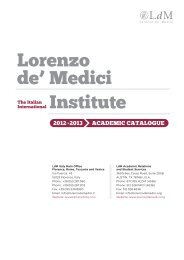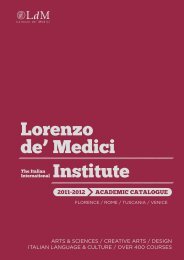aCademiC Catalog 2013-2014 - Lorenzo de Medici
aCademiC Catalog 2013-2014 - Lorenzo de Medici
aCademiC Catalog 2013-2014 - Lorenzo de Medici
You also want an ePaper? Increase the reach of your titles
YUMPU automatically turns print PDFs into web optimized ePapers that Google loves.
TUSCANIA<br />
School of Creative Arts<br />
Discover Painting: Tuscania through Color<br />
and Space<br />
PDM 187 T<br />
Cr: 3; Contact hrs: 90<br />
How is space constructed through the use of color? What is<br />
pictorial space? Why is color such an important element in<br />
<strong>de</strong>sign? What does space do to the content of a painting? How<br />
does color contribute to the expression of content? Why and<br />
how did the painters of the early Christian era use mosaic? How<br />
did they express abstract concepts through the <strong>de</strong>sign of space<br />
and color? How can spiritual content be achieved through the<br />
un<strong>de</strong>rstanding of space, color, form and material? These are<br />
some of the questions that will be addressed in this course,<br />
and we will seek answers to them through actual painting<br />
experience, using the extraordinarily beautiful setting of<br />
Tuscania as a backdrop. Stu<strong>de</strong>nts will be gui<strong>de</strong>d and stimulated<br />
to engage in visual research work that will give insight to their<br />
personal pictorial language. The highlight of the course will<br />
consist of a series of visits to early Christian churches in and<br />
around Tuscania as sources of inspiration. As a general rule,<br />
stu<strong>de</strong>nts will be taken once every other week to a historic<br />
location to paint and then complete the project in the homebased<br />
studio un<strong>de</strong>r the guidance of the instructor.<br />
Discover Painting: Tuscania through Color<br />
and Space (Summer only)<br />
PDM 188 T<br />
Cr: 3; Contact hrs: 60<br />
How is space constructed through the use of color? What is<br />
pictorial space? Why is color such an important element in<br />
<strong>de</strong>sign? What does space do to the content of a painting? How<br />
does color contribute to the expression of content? Why and<br />
how did the painters of the early Christian era use mosaic? How<br />
did they express abstract concepts through the <strong>de</strong>sign of space<br />
and color? How can spiritual content be achieved through the<br />
un<strong>de</strong>rstanding of space, color, form and material? These are<br />
some of the questions that will be addressed in this course,<br />
and we will seek answers to them through actual painting<br />
experience, using the extraordinarily beautiful setting of<br />
Tuscania as a backdrop. Stu<strong>de</strong>nts will be gui<strong>de</strong>d and stimulated<br />
to engage in visual research work that will give insight to their<br />
personal pictorial language. The highlight of the course will<br />
consist of a series of visits to early Christian churches in and<br />
around Tuscania as sources of inspiration. As a general rule,<br />
stu<strong>de</strong>nts will be taken once every other week to a historic<br />
location to paint and then complete the project in the homebased<br />
studio un<strong>de</strong>r the guidance of the instructor.<br />
Telling Stories in Pictures<br />
PDM 192 T<br />
Cr: 3; Contact hrs: 90<br />
This course is <strong>de</strong>signed for stu<strong>de</strong>nts who want to increase<br />
their practical knowledge of illustration and drawing, and for<br />
those who would like to acquire a <strong>de</strong>eper knowledge of iconic<br />
traditions of the popular and applied arts of Southern Italy,<br />
particularly those of Sicily. We will start with an overview of<br />
a communicative artefact, namely a traditional story board<br />
ma<strong>de</strong> by a Sicilian storyteller. Stu<strong>de</strong>nts will learn how to set<br />
the story in context. (What was the purpose, who created it,<br />
and why.) The class will then examine the artefact as a whole<br />
through <strong>de</strong>-contextualization and reuse of the story board<br />
and image panels in a contemporary manner. Stu<strong>de</strong>nts will<br />
have the opportunity to create their own visual tradition in a<br />
contemporary illustrative format. These concepts will start with<br />
the communicative visual traditions typical of Southern Italy –<br />
that extends also to the Maremma and Tuscany and Latium.<br />
Stu<strong>de</strong>nts will finally create a personal visual book which can be<br />
used in different ways: as a poster for story telling, as an artistic<br />
artefact, or as a story board for a vi<strong>de</strong>o.<br />
Telling Stories in Pictures (Summer Only)<br />
PDM 193 T<br />
Cr: 3; Contact hrs: 60<br />
This course is <strong>de</strong>signed for stu<strong>de</strong>nts who want to increase<br />
their practical knowledge of illustration and drawing, and for<br />
those who would like to acquire a <strong>de</strong>eper knowledge of iconic<br />
traditions of the popular and applied arts of Southern Italy,<br />
particularly those of Sicily. We will start with an overview of a<br />
communicative artefact, namely a traditional storyboard ma<strong>de</strong><br />
by a Sicilian storyteller. Stu<strong>de</strong>nts will learn how to set the story<br />
in context. (What was the purpose, who created it, and why.)<br />
The class will then examine the artefact as a whole through <strong>de</strong>contextualization<br />
and reuse of the storyboard and image panels<br />
in a contemporary manner. Stu<strong>de</strong>nts will have the opportunity<br />
to create their own visual tradition in a contemporary illustrative<br />
format. These concepts will start with the communicative visual<br />
traditions typical of Southern Italy – that extends also to the<br />
Maremma and Tuscany and Latium. Stu<strong>de</strong>nts will finally create<br />
a personal visual book which can be used in different ways: as<br />
a poster for story telling, as an artistic artefact, or as a story<br />
board for a vi<strong>de</strong>o.<br />
Tuscania Oil Painting Workshop<br />
PDM 207 T<br />
Cr: 6; Contact hrs: 90<br />
This special summer course takes place in Central Italy, in an<br />
area that inclu<strong>de</strong>s what was once the land of the ancient and<br />
intriguing Etruscan civilization. The ancient cities and towns of<br />
Tuscania, Tarquinia, Orvieto, Civita di Bagnoregio, Rome and<br />
the Lake Bolsena will be the field locations visited during the<br />
course. These visits will inclu<strong>de</strong> open air painting sessions at<br />
specific sights known for their suggestive aesthetic qualities,<br />
as well as visits to three of the main Etruscan museums in Italy<br />
that will enable stu<strong>de</strong>nts to observe Etruscan art first hand and<br />
to sketch on site. The workshop focuses on observation of the<br />
landscape as well as on the architectural and historical richness<br />
offered by these locations. A great <strong>de</strong>al of attention will be<br />
given to the creative interpretation of nature, architectural<br />
<strong>de</strong>tails and historical sites. Color theory and line, form and<br />
proportions will be studied, all based on observation. Particular<br />
emphasis will be given to the interplay of light and color as key<br />
elements in a painting’s mood. Stu<strong>de</strong>nts will be based at the<br />
LdM School in Tuscania and, when not on site, classes will be<br />
held here. Tuscania is an ancient Etruscan hilltown nearby the<br />
seasi<strong>de</strong>.<br />
Tuscania Sketchbook<br />
PDM 231 T<br />
Cr: 3; Contact hrs: 60<br />
This course involves sketching in town and countrysi<strong>de</strong> sites<br />
around Tuscania and then using these sketches to create<br />
finished compositions in the studio. Eighteenth- and nineteenthcentury<br />
landscape painters, for example Turner, Constable and<br />
John Ruskin, would collect drawings and watercolor sketches<br />
in their sketchbooks while on their travels, so as to have a<br />
body of information which they would re-elaborate, often<br />
adding or eliminating elements for effect, in their studios when<br />
they returned home. Outings will be ma<strong>de</strong> to sketch in the<br />
countrysi<strong>de</strong> around Tuscania, at archaeological sites, and in<br />
the streets of the town. Stu<strong>de</strong>nts will be encouraged to gather<br />
as much information as possible through quick pencil and<br />
watercolor sketches, and written notes. In the studio stu<strong>de</strong>nts<br />
will process the information that they have gathered, combined<br />
with the knowledge that they will have gained through<br />
observation of the effects of sunlight and weather conditions<br />
and the way that scenery is put together, to create their own<br />
finished compositions. The object of the course is to <strong>de</strong>velop<br />
the stu<strong>de</strong>nts’ observational abilities along with their creativity<br />
and un<strong>de</strong>rstanding of forms in a process that is an alternative<br />
to the more direct but often constrictive methods of painting<br />
from photography or direct from nature.<br />
Prerequisites: PDM 130 Principles of Drawing and Composition<br />
or equivalent<br />
Intermediate Painting<br />
PDM 270 T<br />
Cr: 3; Contact hrs: 90<br />
The course is structured for stu<strong>de</strong>nts who have already atten<strong>de</strong>d<br />
the foundation-level course or have a similar background in<br />
painting. It takes stu<strong>de</strong>nts into further studies in oil and will<br />
introduce the technique and methods of acrylic painting.<br />
Focus is on the nu<strong>de</strong> as well as object painting using a number<br />
of different approaches to life painting. Some of the most<br />
essential techniques of oil and acrylic painting are covered to<br />
provi<strong>de</strong> stu<strong>de</strong>nts with a sound foundation preparing them for<br />
170<br />
LdM Aca<strong>de</strong>mic <strong>Catalog</strong> <strong>2013</strong>-<strong>2014</strong>





